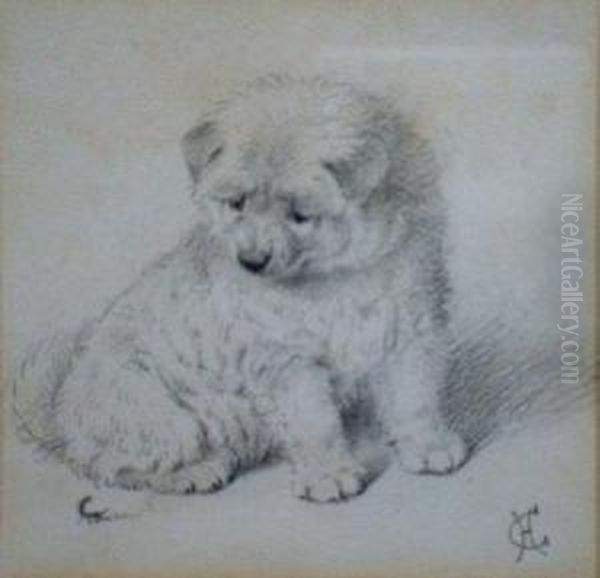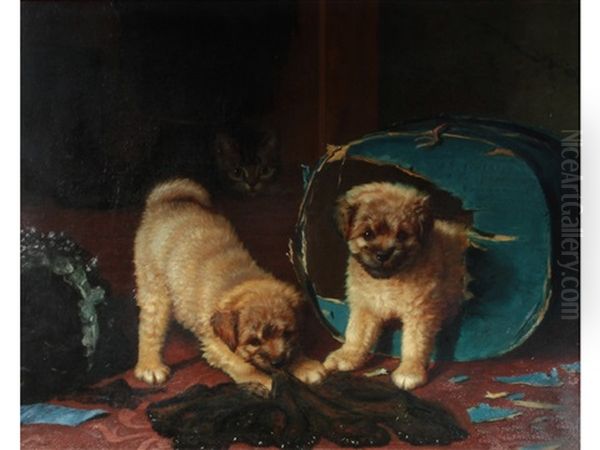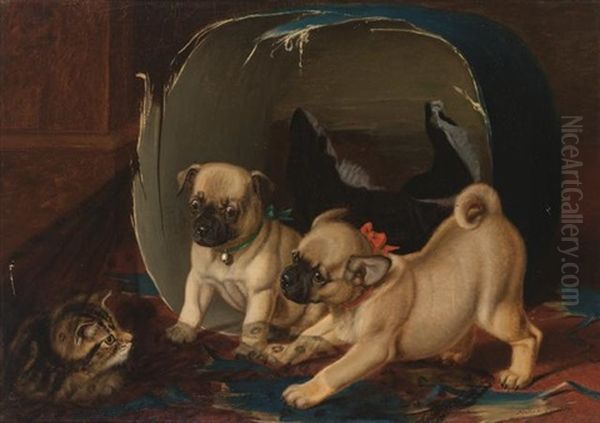Horatio Henry Couldery stands as a notable figure within the rich tapestry of Victorian art, particularly celebrated for his charming and meticulously rendered depictions of domestic animals. While perhaps not possessing the same household recognition as some of his contemporaries, Couldery carved a distinct niche for himself, becoming one of the era's most adept painters of cats and dogs. His work, characterized by keen observation, technical finesse, and a gentle humour, captured the hearts of the public and earned praise from influential critics, leaving behind a legacy that continues to delight animal lovers and art enthusiasts alike. His journey from a craftsman's apprentice to a respected exhibitor at the Royal Academy is a testament to his dedication and innate artistic talent.
Early Life and Artistic Awakening
Horatio Henry Couldery was born in Lewisham, then a part of Kent but now absorbed into Greater London, in 1832. He entered a bustling household as one of nine children. His early path seemed destined for a trade rather than the arts; he initially undertook an apprenticeship to become a cabinet maker or carpenter. This training in craftsmanship, demanding precision and attention to detail, may have inadvertently honed skills that would later serve him well in his artistic pursuits. However, the allure of art proved stronger than the security of a trade.
Couldery made the decisive shift to pursue his passion for painting. Recognizing the need for formal training, he enrolled at the prestigious Royal Academy Schools in London in 1855. This institution was the crucible for many of Britain's finest artists, providing rigorous instruction in drawing, anatomy, and composition. Studying within its walls placed Couldery amidst the currents of contemporary British art and equipped him with the foundational skills necessary to translate his observations of the natural world onto canvas. His decision to abandon his initial trade for the uncertain life of an artist underscores a deep-seated commitment to his calling.
Launching a Career: Exhibitions and Recognition

The culmination of Couldery's training and early efforts came in 1861 when he made his debut at the esteemed Royal Academy Summer Exhibition. His first exhibited work, titled On Dangerous Ground, immediately signalled his thematic interest and skill. The painting, depicting two tabby kittens discovering a fish left unattended on a table, showcased his ability to capture animal behaviour and create a subtle narrative. This successful debut marked the beginning of a long exhibiting career.
Following his initial success, Couldery became a regular contributor to major London exhibitions. His works were frequently seen not only at the Royal Academy but also at the British Institution and the Royal Society of British Artists (often referred to by its location, the Suffolk Street Gallery). Consistent presence at these venues was crucial for an artist's visibility and reputation in the competitive Victorian art market. Couldery's focus on domestic animals, particularly cats and kittens, resonated with the Victorian public's growing affection for pets and their appreciation for scenes of domestic life and natural history.
The Couldery Style: Detail, Texture, and Personality
What distinguished Horatio Henry Couldery's work was his extraordinary ability to render the textures and details of his subjects, combined with a sensitive portrayal of their individual personalities. He possessed a remarkable eye for the subtle nuances of animal anatomy and behaviour. His depictions of fur, particularly the soft, dense coats of kittens, were rendered with painstaking care, inviting the viewer to almost feel the texture. This meticulous approach extended to the animals' surroundings, whether it be the weave of a basket, the grain of wood, or the sheen of pottery.
Beyond mere technical accuracy, Couldery imbued his animal subjects with a sense of life and character. He excelled at capturing the inquisitive glances, playful pounces, and serene repose of cats and dogs. Unlike the sometimes overly sentimental or anthropomorphic depictions by artists like Sir Edwin Landseer, Couldery generally maintained a sense of naturalism, observing his subjects with a blend of empathy and gentle humour. His animals behave like animals, driven by curiosity, instinct, or the simple comforts of warmth and companionship. This realistic yet affectionate approach was key to his appeal.

His technique often involved fine, precise brushwork, building up layers to achieve depth and luminosity. The influence of earlier masters of detailed realism, perhaps even echoing the meticulousness seen in Dutch Golden Age painting or the detailed naturalism favoured by the Pre-Raphaelites (though his subject matter differed), can be sensed in his approach. Artists like William Holman Hunt or John Everett Millais, in their early work, shared a similar commitment to observed detail, albeit applied to different themes. Couldery applied this intensity of observation to the domestic sphere.
The Feline Muse: Couldery's Cats
While he painted dogs and other animals, Horatio Henry Couldery is most renowned for his paintings of cats and kittens. He seemed to possess a particular affinity for felines, capturing their unique blend of independence, curiosity, elegance, and mischief. Victorian England saw a surge in the popularity of cats as household pets, and Couldery's work tapped into this cultural trend. His canvases often feature kittens exploring their environment, interacting with objects, or nestled cozily in baskets, creating scenes of domestic charm and warmth.
His cat paintings frequently explore themes of curiosity, playfulness, and maternal care. Works often depict kittens tentatively investigating new objects, tumbling in play, or observing the world with wide-eyed wonder. He masterfully conveyed the liquid grace of a cat's movement and the intensity of its gaze. The subtle narratives embedded in his paintings – a spilled milk jug, an overturned workbasket, a tense standoff with a caged bird – added an element of storytelling that engaged the viewer. He ranks alongside continental contemporaries like the Dutch-Belgian artist Henriëtte Ronner-Knip, who also specialized in popular and highly detailed cat paintings, though their styles differed.
Signature Works: Capturing Moments
Among Couldery's most recognized works is On Dangerous Ground, his 1861 Royal Academy debut piece. This painting exemplifies his early skill in composition, texture, and narrative. The tension is palpable as the kittens approach the forbidden fish, their cautious curiosity perfectly rendered. The textures of the kittens' fur, the wooden table, and the glistening fish demonstrate his meticulous technique. This work is now held in the significant Couldery Collection at the Glanmore National Historic Site in Canada.
Another iconic painting is Curiosity. While several works might bear similar titles reflecting a common theme, one well-known composition features kittens clustered around a small cage, perhaps containing a mouse or bird. Their focused attention and varied postures – some peering intently, others perhaps ready to pounce – showcase Couldery's understanding of feline behaviour. Such works highlight the blend of innocence and predatory instinct inherent in cats, captured without judgment, simply observed with artistic fidelity.

Other titles attributed to him, such as A Family of Pomeranians, A Cat and Two Dogs, Playful Kittens, and Sympathy, further illustrate the range of his domestic animal subjects. Each work typically displays his characteristic attention to detail and affectionate portrayal of animal life. He often used props like baskets, barrels, pottery, and textiles to frame his subjects and add visual interest, grounding his animal portraits in believable domestic settings.
Beyond the Easel: Illustrations and Commercial Reach
Couldery's talents were not confined solely to fine art painting for exhibition. Like many artists of the period, including notable figures such as Myles Birket Foster or Kate Greenaway, he also engaged in illustration work. His charming and detailed animal depictions were well-suited for children's books and potentially periodicals or greeting cards. This commercial work would have broadened his audience and provided an additional source of income.
While specific titles of books he illustrated can be difficult to track definitively, his style lent itself perfectly to the burgeoning market for illustrated children's literature in the Victorian era. His ability to create appealing and relatable images of animals made his work desirable for publishers seeking to capture the imaginations of young readers. This aspect of his career further cemented his reputation as a skilled depicter of the animal world, reaching homes beyond the circles of fine art collectors. Some sources mention contributions to publications like The Scotsman, though illustration work for major illustrated news magazines like The Illustrated London News or The Graphic, common outlets for artists like Luke Fildes or Hubert von Herkomer, might also have been possible, though less documented for Couldery.
Critical Acclaim: The Ruskin Connection
A significant endorsement of Couldery's work came from one of the most influential art critics of the 19th century, John Ruskin. Known for his championing of artists like J.M.W. Turner and the Pre-Raphaelites, Ruskin's opinions carried considerable weight. In his Notes on the Royal Academy for 1875, Ruskin singled out Couldery's cat paintings for praise, albeit with his characteristic nuance.
Ruskin admired the technical skill, commenting on the paintings' "truth to nature" and remarking on the "most delicate and Dürer-like engraving" quality of the fur rendering. He wrote that Couldery's work was "quite marvellous in its mimicry," and specifically praised the "finish of the tabby markings." He found the paintings "altogether exquisite," connecting their skillful execution to the inherent nature of the cat itself – subtle, precise, and finely detailed. Coming from Ruskin, who could be notoriously critical, this was high praise indeed and would have significantly boosted Couldery's standing. Ruskin's comparison to the meticulous detail of Albrecht Dürer highlights the perceived quality and precision of Couldery's brushwork.
Couldery and His Contemporaries: A Place in Victorian Art
Horatio Henry Couldery worked during a period rich in artistic talent and diverse movements. While he focused on animal painting, he exhibited alongside artists representing the breadth of Victorian art, from the high narrative paintings of Lord Frederic Leighton and Lawrence Alma-Tadema to the social realism of Frank Holl and the landscape traditions carried on by others. Within the specific genre of animal painting, he had notable contemporaries both in Britain and abroad.
In Britain, the towering figure of Sir Edwin Landseer dominated the previous generation with his dramatic and often anthropomorphized animal subjects. Couldery's work offered a quieter, more domestic counterpoint. Briton Rivière was another prominent painter of animals, often incorporating them into historical or narrative scenes. Couldery's focus remained more intimate. Other British artists specializing in animals included John Emms, known for his vigorous paintings of hounds, Arthur Wardle, who painted domestic and wild animals, and later, Louis Wain, whose depictions of cats would become increasingly stylized and eccentric.
Couldery's detailed realism finds parallels in the work of artists like William Huggins of Liverpool, known for his intense studies of animals, or even the precise rendering seen in some works by John Frederick Herring Sr. and Jr., famous for their equestrian portraits. Compared to the broader scope of French animalier Rosa Bonheur, Couldery's focus was narrower but executed with comparable dedication to his chosen subjects. His specific niche, the highly finished depiction of domestic cats and dogs, set him apart.
The Couldery Family Legacy: The Glanmore Collection
A substantial part of Horatio Henry Couldery's surviving oeuvre owes its preservation to his family. In the 1880s, two of his siblings, Bertram and Cecilia Couldery, emigrated to Belleville, Ontario, Canada. They brought with them a significant number of Horatio's paintings, as well as works by other family members. This collection formed the basis of what is now housed at the Glanmore National Historic Site in Belleville.
The Couldery Collection at Glanmore is considered the largest public collection of his work, comprising around 42 paintings. It provides an invaluable resource for understanding the scope and quality of his art. The existence of this collection, carefully maintained and displayed, has been crucial in keeping Couldery's name and artistic contribution alive, particularly outside the UK. It stands as a testament to his family's pride in his achievements and their foresight in preserving his legacy across the Atlantic.
Later Years and the Question of Dates
Information about Couldery's later life is less detailed than that of his active exhibiting period. He continued to paint, but like many artists, his prominence may have fluctuated with changing tastes. A significant point of confusion has surrounded his date of death. For many years, sources variously cited 1893 or 1918. The 1893 date appears to have stemmed from a possible confusion or error in earlier records. The 1918 date also circulated for some time.
However, more recent research, likely drawing on genealogical records and information associated with the Glanmore collection and family history, points strongly to a later date. The most reliable evidence currently available indicates that Horatio Henry Couldery died on February 14, 1920. His death occurred at Egroveton Villa, Addington, near Croydon in Kent (now part of Greater London). This revised date places his lifespan firmly into the early 20th century, meaning he witnessed the dramatic shifts in art that occurred around the turn of the century, although his own style remained rooted in Victorian realism. The earlier reported death date of 1893, mentioned in some sources alongside a small estate value, likely contributed to an underestimation of his later life and career duration.
Enduring Appeal and Artistic Heritage
Horatio Henry Couldery's artistic legacy rests on his exceptional skill in capturing the essence of domestic animals, particularly cats. His work transcended mere pet portraiture; it offered finely crafted studies of texture, light, and animal psychology, presented with charm and technical brilliance. His paintings were admired by critics like Ruskin and beloved by a public increasingly fascinated by the animal world and scenes of domestic life.
While the grand narratives and avant-garde experiments of some contemporaries may have overshadowed his quieter genre, Couldery's contribution remains significant within the field of animal painting. He brought a level of dedication and observational acuity to his subjects that elevated them beyond simple illustration. His ability to convey the unique character and subtle beauty of cats and dogs ensures his work continues to resonate with viewers today. Artists like Maud Earl, who followed him in specializing in dog portraiture, built upon the tradition of detailed animal painting that Couldery represented.
Conclusion
Horatio Henry Couldery navigated the bustling Victorian art world to establish himself as a preeminent painter of cats and dogs. From his beginnings as a craftsman apprentice, he rose through dedication and talent to exhibit regularly at London's most important venues, earning critical praise and public affection. His meticulous technique, keen observation of animal behaviour, and ability to imbue his subjects with personality define his artistic signature. Though historical records presented some confusion regarding his final years, his legacy is securely preserved through his surviving works, most notably in the family collection at Glanmore. Couldery remains a cherished figure for those who appreciate the artistry involved in bringing the animal world to life on canvas, a master of the feline form and a quiet chronicler of Victorian domestic life.